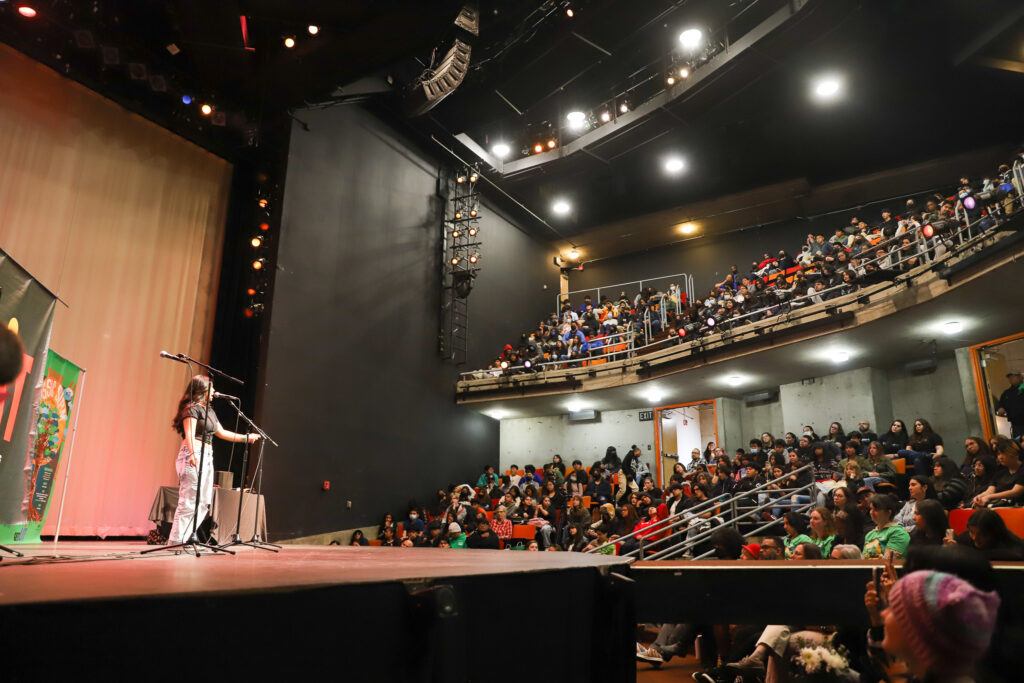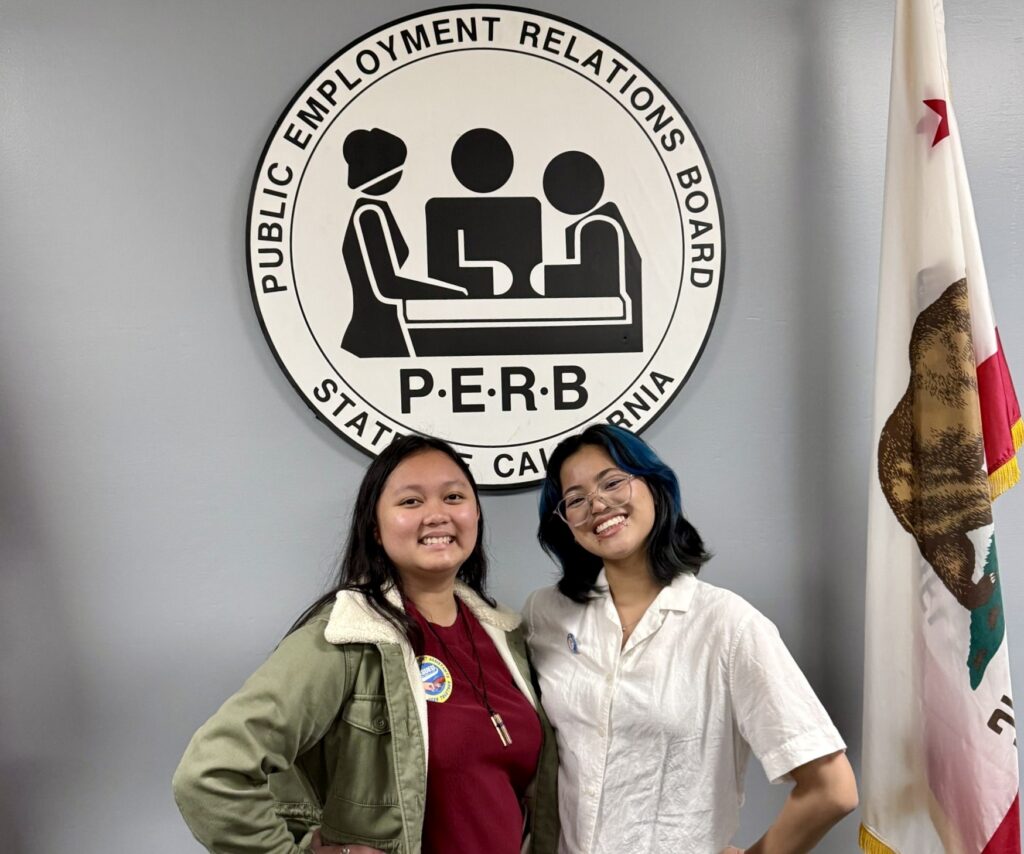
A student performs a poem at the quarterfinals of the 12th annual Get Lit Classic Slam.
Photo Credit: CJ Calica
Salome Agbaroji wrote her first poem, a rap, in the second grade, and she’s been crafting rhymes ever since. Now the 18-year-old Harvard student is best known as the nation’s youth poet laureate.
“I have always loved poetry,” said Agbaroji. “Even before I knew it was poetry, I started loving rap music, so I’ve always loved poetry and using words creatively. That’s always just been what I gravitated to, even as a young, young child.”
A Nigerian-American poet from Los Angeles, Agbaroji has performed spoken word poetry for the Golden Globes, an NFL halftime show, and she’s talked poetry with President Joe Biden at the White House. Her passion for spoken word performance began back at Gahr High School in Cerritos, where her love of words was further fueled by the arts education nonprofit Get Lit-Words Ignite.
“Get Lit is an amazing organization, giving you the space and the opportunity to share your voice and to be creative and to be wild and to be heard,” says the eloquent teenager who believes in the power of poetry to combat rising illiteracy and injustice. “They shined a light on me. They made such a big impact on my whole journey.”

Amid a deepening literacy crisis, Get Lit spreads a love of literature through spoken word poetry and performance. Founded by actor/writer Diane Luby Lane in 2006, Get Lit, which recently received $1 million from philanthropist MacKenzie Scott, teaches classical poetry as well as empowers children and teens to write their own poems in over 150 Los Angeles schools, instilling a love of language in a generation often struggling with literacy.
“Spoken word really helps with literacy,” said Lane. “It really helps when you put your body on the line, when you’re not just listening passively, but you’re actually memorizing, you’re performing, you’re responding with your own words. It’s such an interactive experience.”
Get Lit reaches out to roughly 50,000 students a year, ranging from fourth grade to high school, through its school-based programs. The curriculum is a deep dive into great literature, from T.S. Eliot to Maya Angelou, that culminates in a three-day Classic Slam, the largest classic youth poetry competition in the country.
The Classic Slam “is really worth attending if you can, it is mind-blowing and so inspiring to witness,” said Malissa Feruzzi Shriver, co-founder of Turnaround Arts: California, a nonprofit that works in elementary and middle schools. “Students who participate benefit in so many ways; they gain confidence and poise and become empowered to use their voice in a unique way.”
Along the way, they teach the power of recitation, as well as how to amplify your own voice amid the noise of the social media age. The students come to hear the echoes in the ancient, putting the past in dialogue with the present.
“We always say a classic isn’t a classic because it’s old, a classic is a classic because it’s great,” Lane said. “We’re redefining what the canon is.”
Finding the joy in literacy can be a powerful message for children who don’t always feel celebrated in the school system, some say. Roughly 85% of Get Lit’s students are from under-resourced communities and 92% are students of color.
“Kids are sitting in school for eight hours a day, either being bombarded by facts and information or being asked to regurgitate those facts and information,” said Agbaroji, who has written poems that explore race, community and history. “Writing is like the one space, the one little pocket in an eight-hour school day where students actually can do something themselves, create something that they can say is mine and no one can take it away from me.”
Ironically, Lane says that while some adults dismiss the study of poetry as a stilted and staid pursuit, most youths have far more open minds.
“It’s an easy sell with the kids. Very easy,” she says with a smile. “The elementary schools have been begging for it. You know how good young kids are at memorizing things. And sometimes their own responses are so deep. It’s unbelievable.”
Get Lit tries to respond to each child’s distinctive needs, experts say, tapping into what makes that student unique, how to help them shine.
“They are doing amazing work,” said Merryl Goldberg, an arts advocate and veteran music and arts professor at Cal State San Marcos. “One of the things that I really like about what I know about them is that they incorporate community and student needs into their mission focused on poetry.”
Lane says she knows just how to frame poems so that Tennyson and Tupac have equal pull with students and tries to shed light on the universality of poetry to capture the human experience.
“We say, claim your poem, claim your life,” said Lane. “Because I am approaching it as an actor, I can pull Wordsworth pieces that make the kids raise their hand and fight over poems, and we’re mixing this with a lot of contemporary voices. Tupac is a great poet. The mixture allows for students to find themselves however they want to.”

Parsing one word at a time, the way a poem requires, may be most ideal for struggling readers, Lane adds, who prefer to savor each syllable instead of speeding along the page.
“My daughter, she was diagnosed with dyslexia. It was really hard for her to get through a whole book. It just was,” says Lane. “So many children in our school districts, their reading skills are not great, but their emotional IQ is high. So a poem gives them the opportunity to study something short but deep. It’s an absolute game changer. It changes the entire culture of a school.”
She’ll never forget teaching poetry to her daughter’s fourth grade class. She had them learn Angelou’s iconic “Still I Rise” by heart and watched the fourth graders light up with pride.
“Here’s a kid that struggled with reading that doesn’t feel like they’re smart, but now they have this whole poem memorized,” she said. “They learn to perform it really well. They write their own response back to it. It’s deeply empowering. And they do it for the whole grade or class or school. And they get to feel really powerful by mastering short form content. That’s deep.”



